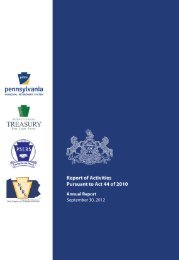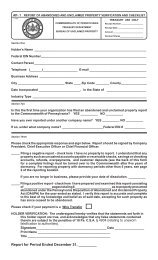Georgia Gaming Market Assessment - Pennsylvania Treasury
Georgia Gaming Market Assessment - Pennsylvania Treasury
Georgia Gaming Market Assessment - Pennsylvania Treasury
You also want an ePaper? Increase the reach of your titles
YUMPU automatically turns print PDFs into web optimized ePapers that Google loves.
gamer visits thus generated are then distributed among the competitors based upon the size of<br />
each facility, its attractiveness and the relative distance from the zip code in question. The<br />
gravity model then calculates the probabilistic distribution of gamer visits from each market area<br />
to each of the gaming locations in the market.<br />
Each travel distance/time is evaluated to determine the likely alternative gaming choices for<br />
residents of the region. The model is constructed to include only those alternative venues that<br />
are considered to be within a reasonable travel time. These include competing casinos that have<br />
the potential to attract patrons, or siphon off visits from the market. Travel distances and time<br />
have been developed through use of our GIS system.<br />
The following section provides a description and definition of the various components of the<br />
model.<br />
Gamer Visits<br />
This measure is used to specify the number of patron trips to a gaming market, where an<br />
individual can make any number of separate visits in the course of a year. In order to estimate<br />
the gamer visits, market penetration rates, made up of the separate measures of propensity and<br />
frequency, are applied to the adult population in each zip code. A gamer visit can include more<br />
than one visit to a casino.<br />
Propensity<br />
Propensity measures the percentage of adults who will participate in casino gaming within the<br />
zip code. This varies based upon a number of factors, which includes the number of gaming<br />
venues, their type (i.e. landbased versus cruising riverboat versus dockside riverboat), games<br />
permitted, availability of other entertainment and leisure options, and most importantly distance<br />
from a gaming venue. Propensity in the inner market areas from 0-50 miles can vary between<br />
the high thirty per cent range in a single cruising riverboat market to the fifty percent range, or<br />
more, for multiple land based casinos with a well developed array of amenities.<br />
Frequency<br />
This measures the average number of visits that an adult will make annually to casinos in the<br />
subject market. Frequency is a function of annual gaming budget as indicated by income<br />
variations, the number of venues in the market, the type of gaming facility and most importantly<br />
distance from a gaming venue.<br />
Win per Visit<br />
Win per visit varies not only by gaming jurisdiction, but also in some cases by individual<br />
facilities. Normatively, win per visit is a function of distance and income. Gamers traveling<br />
greater distances tend to spend more per visit, typically making fewer gamer visits on average.<br />
Attraction Factors<br />
Attraction factors measure the relative attraction of one gaming venue in relation to others in the<br />
market. Attraction factors are applied to the size of the gaming venue as measured by the<br />
number of positions it has in the market. Positions are defined as the number of gaming<br />
machines plus the number of seats at gaming tables. A normative attraction factor would be one.<br />
The Innovation Group Project #054-11 August 2011 Page 69





